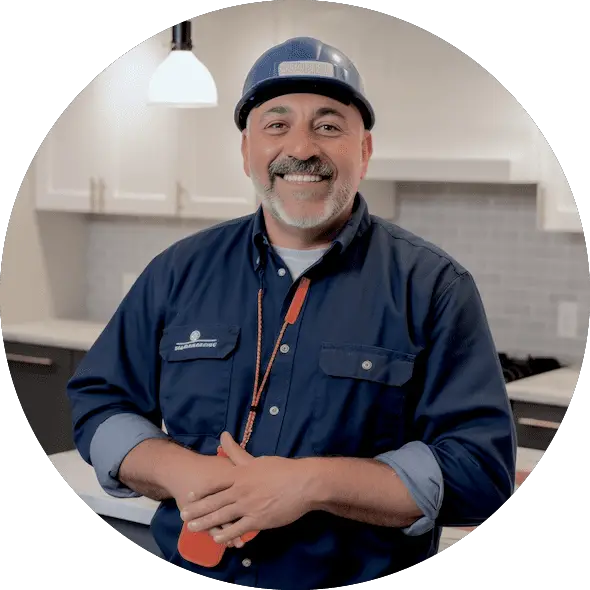It can be hard to decide which type of blower is best for your home. Ensuring the hood will provide adequate ventilation is essential. If the vent does not work, grease, smoke, and odors stay in your kitchen. Local and inline blowers offer unique benefits, but which one is better for you? And what’s the difference between a local blower and an inline blower anyway?
This article discusses the different types of blowers and their benefits. We also highlight the differences between local and inline blowers so you can decide which is right for you.
A local blower sometimes referred to as an internal blower, is a blower that is located directly inside your range hood. An inline blower is a remote blower not located in the range hood itself but in your ductwork, between the range hood and the end of your ducting.
What are the types of range hood blowers?
There are three main varieties of blower range hoods used to vent the kitchen’s stale air:

- Local blowers
- Inline blowers
- External blowers
Local blowers
A local blower, often called an internal blower, is a blower that is installed within your range hood. Because this fan is close to the filters and the kitchen, it can filter out more airborne pollutants. Also, since it is built into the range hood, it may be louder than a separate external fan.
Inline blowers
Inline blowers, also called “inline fans,” are remote blowers in your ductwork between your range hood and where the air goes. If you often host dinner parties or want to have people over and have a good time in the kitchen, a hood with an inline blower motor is a great investment. There is less suction power, but they are significantly less noisy.
These fans can still move up to 1300 CFM of air out of your kitchen while running on low power, which is more than adequate for any cooking. When it comes to forcing air through ductwork, inline fans are better than extractor fans. So, put the fan near the duct’s intake rather than its output, particularly for extended runs.
External blower
A house with an external blower has a fan outside the building. The normal placement for a blower of this kind is on the roof of a building. A more costly option than local or inline blowers, but one that will leave your kitchen in peace. In addition, the hood may be completely silent while in operation.

COSMO COS-63190S Wall Mount Range Hood

COSMO COS-63190S Wall Mount Range Hood
What’s the difference between an inline blower and a local blower
There are contexts when the terms “inline blower” and “inline fan” are used interchangeably. When talking about the ventilation system of your range hood, the term “local blower” refers to a fan built into the hood. An internal blower is another name for this design
How do I know which blower is best for me
Most new range hoods will come with a default blower rather than allow you to choose one. However, you have complete control over the maximum CFM output. Therefore, if you want a strong blower, you need a hood with plenty of CFM.
If you want even more tips and insights, watch this video called “Remote Blower Vs. Local Blower – Different Blower Types” from the Proline Range Hoods YouTube Channel.
A video called “Remote Blower Vs. Local Blower – Different Blower Types” from the Proline Range Hoods YouTube Channel.
Frequently asked questions (FAQ)
Do you still have questions? Below are some of the most commonly asked questions about local and inline blowers.
What is a range hood?
A range hood, vent hood, or kitchen hood is a piece of equipment often put above a stove or cooktop to collect, filter, or vent away oil and steam. A range hood, which often has a fan built-in, can be mounted above the stove to improve the lighting above the stovetop.
What is a range hood blower?
Your range hood’s blower is its beating heart. The suction the motor creates is needed to push the stale air up and out of your kitchen through the vents. There is a vast range of blowers, some of which are more powerful than others. Choosing a range hood with the appropriate motor arrangement and wattage is crucial.
What is CFM?
Whenever air is being moved from one location to another, the cubic feet per minute (CFM) flow rate is crucial to keep in mind. An appliance’s CFM rating is based on how well it performs at its designated task and how quickly air moves through it.
Conclusion
Understanding the differences between local and inline blowers can be tricky at times. By now you should have a better idea of what each one does and when to use them.
This article covered the types of range hood blowers, the difference between inline and local blowers, and whether an inline fan is the same as an exhaust fan. Here are some key takeaways:
Key takeaways
- There are three main varieties of blower range hoods used to vent the kitchen’s stale air
- When talking about the ventilation system of your range hood, the term “local blower” refers to a fan built into the hood.
- The inline exhaust fan works the same as a regular exhaust fan, but it looks different.
- Ensure the duct size is up to code since airflow produces noise using a remote, inline, or internal blower. The number of duct twists should be kept to a minimum.
So, which one do you prefer, the inline or local blowers? And did I cover everything you wanted to know? Let me know in the comments section below (I read and reply to every comment). If you found this article helpful, check out my full blog for more tips and tricks in your kitchen. Thanks for reading, and stay safe.















